
Why Van Gogh’s work still has vitality, and Jeff Koons’ work was stillborn.
Admittedly, Van Gogh’s work DOES suffer from posthumously being made into a whopping cliché. He’s been sentenced to the level of over-reproduction that guarantees most people will be sick of his work before they ever have a chance to understand it, the same way I grew to hate certain songs, like Sympathy for the Devil by The Stones, before I ever had an opportunity to hear them fresh. I used to run to change the station when that song would come on, because it was so overplayed. A couple weeks ago, after not hearing it for years, I noticed the percussion for the first time. It actually rocks. And Vincent rocks.
I see a movie preview and think, that’s all been done before, and better. I just sat through one for a horror movie that ripped off the original Poltergeist of thirty years ago. Watched Elysium a few days ago and thought the overblown CGI action scenes had nothing on Terminator 2: Judgement Day of 22 years ago (a disappointing “for the masses/money” effort after the much more original, thoughtful, and even visionary District 9). In Van Gogh’s paintings, we can see the genesis of much work to come, including the work of Francis Bacon and the American school of Abstract Expressionism, as well as his fusion of influences as disparate as Jean-François Millet, and Pointillist, Georges Seurat. Not much has lived up to the standard he set.

I was corresponding with another artist blogger, the extremely witty Alistair Gentry, about the influence of Millet on Van Gogh, and while doing a little research happened upon a hi-rez reproduction of Van Gogh’s, “The Sower”. I was stopped in my tracks.
Van Gogh was a passionate, humble, and hard-working fellow who identified so much with the worker that he himself painted outside in the sun. As the sower or the reaper, Vincent was out in the heat of the day tilling the canvas, and laying down rows of paint (pardon the cheesy metaphors).
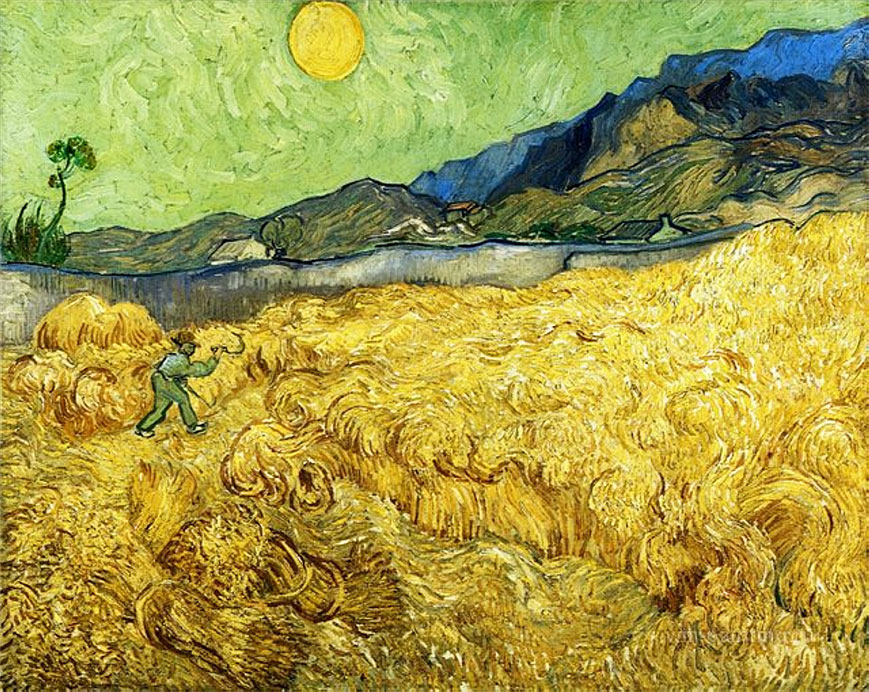

In the above image we can see Vincent humbly trundling to his workday, laden with the tools of his trade. That’s what I call dedication, and a literal empathy for peasant workers. Below is Francis Bacon’s work in celebration of Vincent’s depictions of himself as a painter in-and-of the landscape.
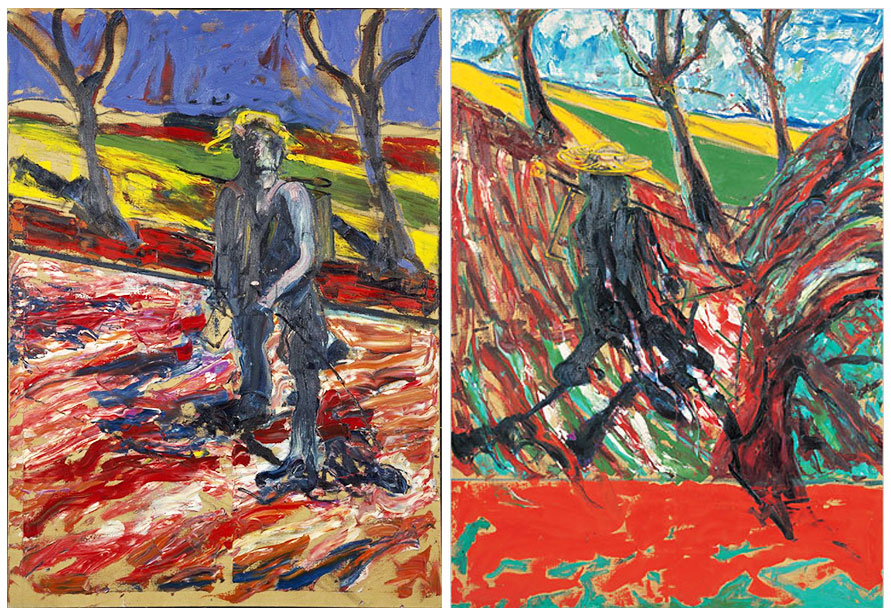
Van Gogh’s “Sower” is a masterpiece that mercifully hasn’t been shoved in our noses as much as “The Starry Night” or “Wheatfield with Crows“. There’s a chance we can appreciate it freshly. The canvas is alive. Click on the image below to go to a high-rez version, then click again for even more detail.
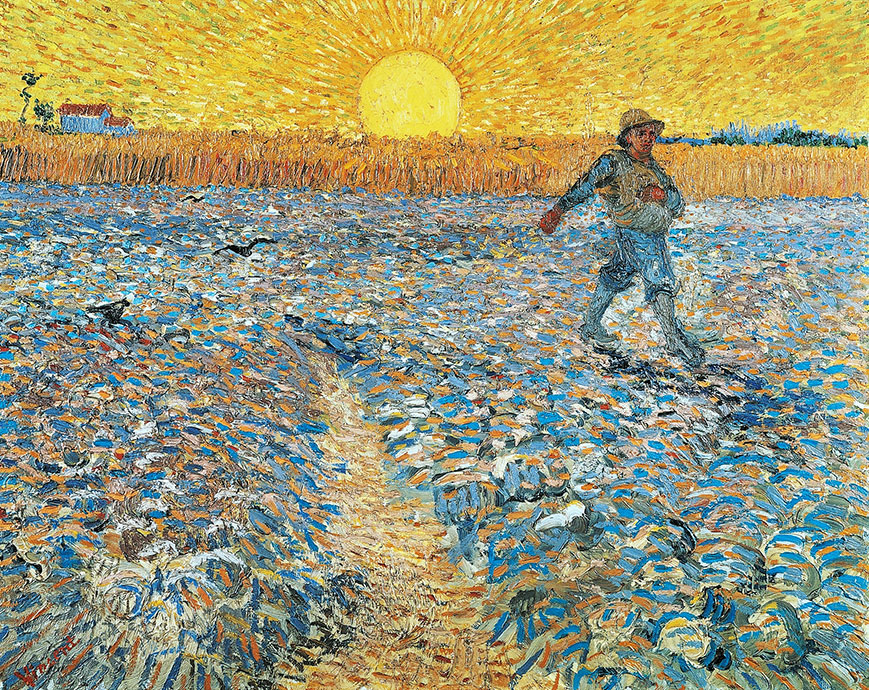
Vincent’s work remains fresh today, and it may have something to do with his intense sincerity, honesty, dedication, and humility. That’s not something we contemporary artists tend to aspire to. Seems a bit unsophisticated. We like to take clever pot shots from a safe distance. Take Jeff Koons‘ quintessential “Michael Jackson and Bubbles” for example – a deliberately kitsch parody of Michael Jackson, and his pet monkey, “Bubbles”, dressed similarly.
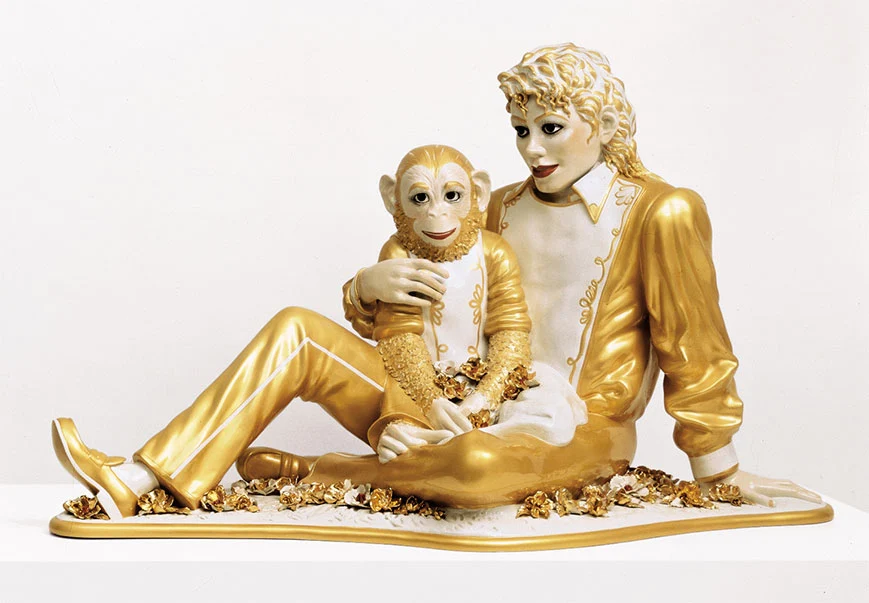
We look at this porcelain sculpture, ostensibly by Jeff Koons – he didn’t make it, he just had the idea and paid some un-credited Italian specialists to actually sculpt the thing – and to a large degree its success is due to the consummate craftsmanship. It is, after all, art. But the real “art” is – if one is among the cognoscenti cultured enough to appreciate it – the shinning, unalloyed, brilliance of Koons’ idea of making a white Michael Jackson with a white monkey in white porcelain. I get it. Paaah! The idea is cutesy and sort of makes a safe tidbit of social commentary, while claiming for itself monumental philosophical import: but it’s only the actual realization of the idea, done by others, that makes the piece anything other than a joke. My favorite factoid is that Koons had THREE of these things made, so he could have three separate simultaneous openings. One of the copies has already sold for over five million dollars. This piece belongs to Koons’ “Banality” series, and herein lies the problem. A wry and cynical twist on banality is just never going to be very interesting other than to the ultra-rich or jaded, who don’t (need to) concern or sully themselves with the more essential demands and hardships of life. They can scoff from the balcony seats. It’s ideal for an audience whose pressing issue is what fashion to spend their disposable income on. Ultimately, however, a reexamination of insipid dullness and superficiality can’t be exciting or invigorating.
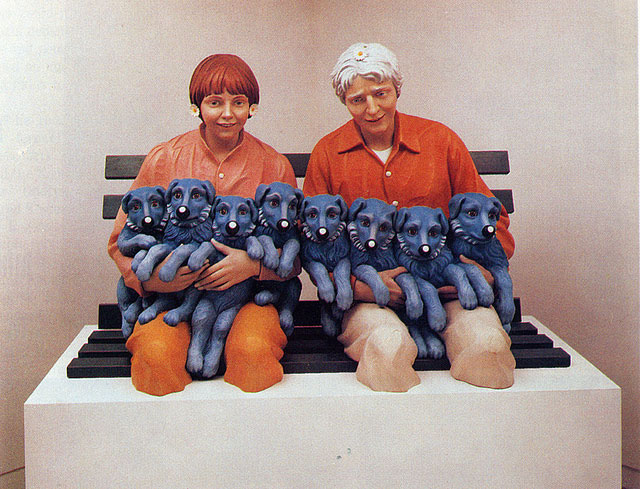
Koons “String of Puppies” was based on a photo by Art Rogers, and Rogers successfully sued Koons for copyright infringement. Once again, all Koons did was conceive the idea. According to Wikipedia, “Koons found the picture on a postcard and, when he gave it to his assistants with instructions on how to model the sculpture, he asked that as much detail be copied as possible. He requested a few changes to the original, asking for the puppies to be blue with exaggerated noses, and for flowers to be added to the hair of the man and woman.” So, the artist had the foresight to have his assistants copy an extant photograph, with a couple flourishes to cheese it up. All hail unfettered genius!

What makes Koons’ art “great” is its cleverness, and his primary tools are access-to-money and connections-to-the-artworld. He’s more of a CEO than an artist. Indeed, he employed over 100 people to make his art for him. It’s I’m-smarter-than-you art, and people like it because they don’t want to feel like the hopelessly ignorant and unsophisticated people who can’t hope to fathom it. They want to feel-up-to-date and in-the-know by riding the cusp of the wave of civilization via the work of pioneering artists. There’s such an emphasis on being smarter, or out-smarting, or art-historical one-upmanship, that skill becomes derided or irrelevant. It’s more about celebrity and fashion, which the more affluent can appreciate as their terrain, and as a flattering reflection on their lifestyles and themselves. The works are perfectly digestible by the status quo. Then again, a gilded shallow pool is still shallow, and cerebral attempts to deny meaning and authenticity are just a thin veneer on meaningless inauthenticity.

Koons’ “banality” series were dead on arrival in however many galleries they opened up in, and however many millions they fetched, despite their slickly heroic attempt to make superficiality profound. The sterilization of any authenticity or sincerity in art may not be so much a sign of a new breed of sophistication, but of cowardice. Koons doesn’t dare to try to say something directly meaningful, say in a human, or even a heart-felt way. His art is about art. He makes objects that he places as rhetorical markers in the evolution of art history, which also have little or no significance outside of that paradigm. His work doesn’t speak to us directly, because you need to be up on your Post Modernist theory and its underpinnings to understand the message in context. The art is in the service of an idea and a belief system. Outside of the museum/gallery simulacrum, Koons’ work reverts back to kitsch, just as Duchamp’s infamous urinal, when taken out of the pantheon of art history, belongs in a public restroom.
Van Gogh’s art has already outlived that of Jeff Koons (one of the best known contemporary artists) because Vincent strove tirelessly to discover and convey meaning and life in his work (as cliched as that sounds, sometimes it’s true). In the end, sincere conviction and an attempt to make something new and profound trumps ironic remove and a facile appropriation of trivia.
If you’re thinking I don’t like any contemporary art, because, well, if you were to be brutally honest, my ass-backwards mind can’t decipher it’s crystalline brilliance, I wrote a review on a practicing contemporary artist who I quite admire here: Andrew Newton. And there are lots of others, though admittedly I tend to like painting.



Always like reading different perspectives on van Gogh; interesting artist, great work and an an intriguing story with so many layers to it.
When I first saw the monk painting, I thought it was interesting. It had a sense of rough calm to it as your brush strokes of the monk had a kind of circular flow that had a kind of contrast to the river like ebbs of the floral decoration in the background. I didn’t initially realise it yours so when you criticised it as derivative I found myself being irritated at the word ‘derivative’ being used as an insult. Additionally, aside from the thick use of paint (I am guessing it is paint), the style is pretty different. Firstly, your colours are a bit darker and the complimentary colours are far more subtle. Also, you don’t seem to enclose any sections with black lines or darker use of paint as Vincent did in some of his work.
I didn’t read the section on Koons. I just don’t find him interesting but I’ve always thought that if an artist evokes reactions to the extent people write about them, then there is value in their work irrespective or whether that emotion is love or hate.
LikeLike
Yeah, I was joking about my piece. I think it’s pretty good. It’s done digitally, and it’s the first one I did in that style. Right, it looks like a painting. When pondering whether or not to work digitally, my biggest reservation is I couldn’t do the impasto painting I like so much. And then I figured out how to approximate it quite well.
Koons is boring. People get more worked up about Damien Hirst, because of his sensationalism. Koons is just about kitsch, cliches, and banality. I chose him as an example of vapid, ironically removed art.
LikeLike
That’s not true. There’s still plenty of artists around today who self-harm and kill themselves.
Well, OK, the ones who actually killed themselves aren’t exactly around today.
But you know what I mean.
LikeLike
Sincerity, honesty, dedication, and humility doesn’t equal killing oneself.
Of course their are sincere artists. I used the word “tend” and I applied to to contemporary artists, and by that I meant artists who practice “contemporary art” and opposed to just anyone who is alive today. “Contemporary art” often means “Post-modernist art” which is a kind of ironic art that’s supposed radicality is how smart it is.
By sincerity I mean trying to make meaningful and even personal art, as opposed to art that is a witty commentary on pop culture, consumerism, fashion or some other superficial thing.
LikeLike
Hey Eric, since digital art is now your thing, maybe you should check out this artist’s work — Corinne Whittaker. She is retirement age, I think and she used to have a gallery in Carmel (CA). I was so surprised to find that such an older person had embraced digital art — She has been at it for about 27-30 years! Her monthly newsletter is The Digital Giraffe. She also does sculptures from the digital work she creates. Site is: http://www.giraffe.com/
LikeLike
Some of her work looks interesting. Looks like she spent a lot of time experimenting with Photoshop. Her website, though, is quite hard to navigate and the pics are really small. Would be nice if she loaded larger images. I always go ahead and put nice big ones. I don’t worry about people stealing them. The originals are many times larger, and the onscreen 72dpi versions are only good for making smallish prints at best.
LikeLike
I’ve been to her home and studio. She has her images printed onto aluminum. Most of them are about the size of three doors! Huge. Cannot imagine the cost of each piece! She also creates 3-D images (sculptures) from her digital works. She has the largest Apple computer screen I have ever seen!
LikeLike
makes it really ironic that her online presentation includes such small images. Yeah, digital art can be printed on all sorts of things.
LikeLike
Yah, some artists worry that people will steal their art and so they try to make it impossible by posting thumbnails. But I say, I say, that’s just silly.
LikeLike